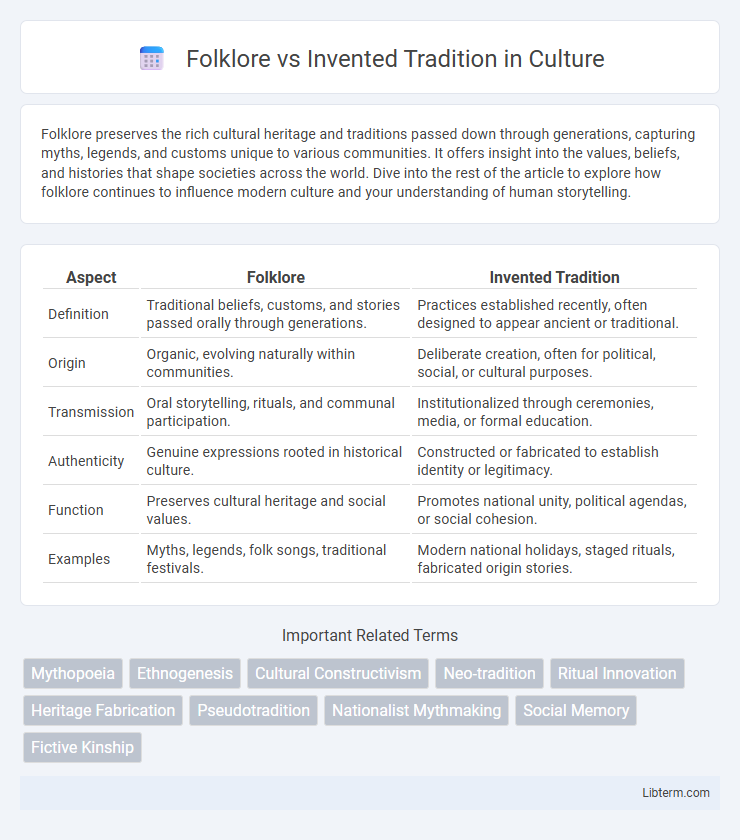Folklore preserves the rich cultural heritage and traditions passed down through generations, capturing myths, legends, and customs unique to various communities. It offers insight into the values, beliefs, and histories that shape societies across the world. Dive into the rest of the article to explore how folklore continues to influence modern culture and your understanding of human storytelling.
Table of Comparison
| Aspect | Folklore | Invented Tradition |
|---|---|---|
| Definition | Traditional beliefs, customs, and stories passed orally through generations. | Practices established recently, often designed to appear ancient or traditional. |
| Origin | Organic, evolving naturally within communities. | Deliberate creation, often for political, social, or cultural purposes. |
| Transmission | Oral storytelling, rituals, and communal participation. | Institutionalized through ceremonies, media, or formal education. |
| Authenticity | Genuine expressions rooted in historical culture. | Constructed or fabricated to establish identity or legitimacy. |
| Function | Preserves cultural heritage and social values. | Promotes national unity, political agendas, or social cohesion. |
| Examples | Myths, legends, folk songs, traditional festivals. | Modern national holidays, staged rituals, fabricated origin stories. |
Defining Folklore: Roots and Characteristics
Folklore encompasses the traditional beliefs, customs, stories, and practices passed down orally through generations, rooted deeply in the cultural and historical context of a community. It reflects authentic social memory and collective identity, often evolving organically without formal authorship. Unlike invented traditions, folklore arises from lived experience and communal transmission, embodying the shared values and norms of a group over time.
What Constitutes an Invented Tradition?
Invented traditions are practices or rituals deliberately created or adapted to establish social cohesion, legitimize institutions, or instill values, often presented as if they have historical continuity. Unlike folklore, which naturally evolves through communal transmission over generations, invented traditions are consciously constructed with specific purposes, sometimes rooted in selective interpretations of history. Key characteristics include formalization, symbolic repetition, and the promotion of collective identity through an often fabricated or exaggerated sense of antiquity.
Historical Origins of Folklore and Invented Traditions
Folklore originates from authentic cultural practices and oral histories passed down through generations, rooted in the lived experiences of communities. Invented traditions are deliberately created or adapted in recent history to establish social cohesion or legitimize institutions, often lacking deep historical continuity. Understanding the historical origins involves distinguishing spontaneous, community-based narratives from constructed rituals designed to simulate age-old customs.
Transmission and Evolution: Oral vs. Constructed Practices
Folklore relies on organic transmission through oral storytelling, songs, and rituals that evolve naturally over generations, reflecting community identity and adaptation. Invented traditions are deliberately constructed practices, often documented and formalized to establish continuity with a selective historical narrative. The evolution of folklore is dynamic and communal, whereas invented traditions are shaped by institutional intent to reinforce specific social or political agendas.
Community Identity in Folklore and Invented Traditions
Community identity in folklore is deeply rooted in authentic historical narratives and shared cultural practices passed down through generations, fostering a genuine sense of belonging. Invented traditions, often deliberately created or adapted, serve to reinforce social cohesion by symbolizing collective values and legitimizing contemporary institutions or practices. While folklore preserves organic cultural memories, invented traditions strategically construct identity to address present societal needs.
Purposes and Functions: Cultural vs. Political Motivations
Folklore serves primarily to preserve cultural heritage, transmitting values, beliefs, and practices rooted in a community's collective identity and history. Invented traditions are often politically motivated, designed to establish or legitimize power structures, promote national cohesion, or reinforce social order through deliberately constructed rituals. While folklore emerges organically over time, invented traditions are strategically created to meet contemporary political or ideological needs.
Authenticity and Authority: Who Decides Tradition?
Authenticity in folklore is rooted in collective memory and lived cultural practices passed through generations, while invented traditions are often consciously constructed to serve present-day social or political purposes. Authority over what constitutes tradition frequently arises from community consensus, academic interpretation, or institutional endorsement, each influencing the validation and perpetuation of cultural narratives. The dynamic interplay between authentic heritage and invented customs highlights the fluid nature of tradition and challenges fixed notions of cultural legitimacy.
Case Studies: Classic Folklore Tales vs. Modern Inventions
Classic folklore tales such as "Little Red Riding Hood" and "The Brothers Grimm" collections showcase narratives passed down through generations, reflecting communal beliefs and cultural values. Modern inventions like the "Elf on the Shelf" illustrate how contemporary traditions are deliberately created and marketed, often lacking deep historical roots but gaining rapid popular acceptance. Comparative case studies reveal that classic folklore embodies organic cultural evolution, whereas invented traditions serve strategic social or economic purposes in modern contexts.
Folklore and Invented Traditions in Contemporary Society
Folklore in contemporary society serves as a dynamic repository of cultural expressions, encompassing oral traditions, rituals, and communal practices that evolve over time while maintaining historical continuity. Invented traditions, by contrast, are consciously created or modified practices intended to establish social cohesion or legitimize institutional authority, often drawing on or mimicking folklore elements to enhance cultural resonance. Both play critical roles in identity formation and social cohesion, reflecting and shaping modern cultural narratives within communities and nations.
Preserving the Past or Creating the Future?
Folklore inherently preserves the cultural identity and collective memory of communities by transmitting customs, stories, and practices rooted in historical continuity. Invented traditions, while often constructed with deliberate origins, serve to shape social cohesion and cultural meaning in the present, thereby creating a future-oriented identity. The dynamic interplay between preserving the past through folklore and shaping the future via invented traditions highlights how societies negotiate heritage to maintain relevance and collective purpose across generations.
Folklore Infographic

 libterm.com
libterm.com